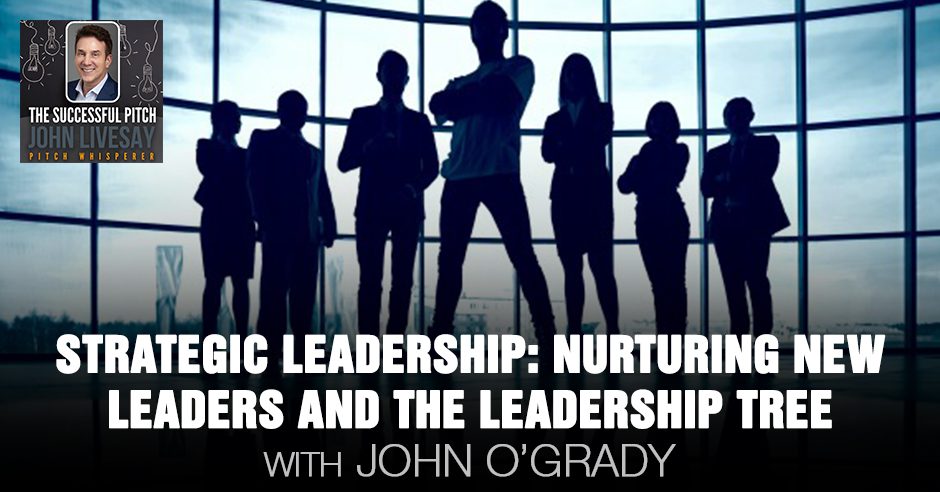Strategic Leadership: Nurturing New Leaders And The Leadership Tree With John O’Grady
Posted by John Livesay in podcast0 comments

Strategic leadership uses the concept of the leadership tree, where you nurture the people under your leadership until they develop to become leaders on their own. Former Division I athlete, West Point graduate, Army Colonel, and leadership coach John O’Grady joins host John Livesay in this episode to share his experience in strategic leadership in challenging situations. He is a distinguished combat leader whose unit was awarded the Presidential Unit Citation for “extraordinary heroism in the face of an armed enemy” in recognition of their exemplary work in Afghanistan. John attributed this success to their values-based culture and used what he learned from this experience to drive his leadership coaching career. His empowering message now benefits coaches, athletes, and corporate organizations through his coaching firm, O’Grady Leadership and Consulting Services, LLC.
—
Listen to the podcast here
Strategic Leadership: Nurturing New Leaders And The Leadership Tree With John O’Grady
Our guest is John O’Grady. He has an incredible background in both athletics and in the military. His company is Strategic Leadership Academy where he takes his lessons learned from the battlefield into the world of Corporate America. He said, “You need to be willing to seek collaboration from wherever it may come.” The kinds of people he likes to work with are those that have both humility and curiosity about how they can learn to grow and raise better leaders. He said, “The key thing about athletics and the military is you have a sense of purpose greater than yourself.” Enjoy the episode.
—
Our guest is John O’Grady and what John does is helps athletes, coaches and executives bring out the best in their players and teams. He’s a former Division I athlete, a West Point graduate, Army Colonel, and a distinguished Combat Leader. John inspires leaders to become the best version of themselves in the most demanding complex, austere and challenging environments. He utilizes the principles he’s developed and practiced for over 30 years in athletics and the army. He works with a diverse group of organizations and he provides leadership, culture, and strategy principles that are fundamental to getting the outcomes of excellence. John has a decorated military career where he led organizations from 30 to 3,500 people in active war zones. One of the things he’s most proud of that we’re going to ask him about is his leadership tree. John, welcome to the show.
Thanks for having me, John, and it’s a pleasure to spend time with your audience as well.
The readers are much in for a treat learning from you. I started to tease out what your leadership tree is. Can you take us back a little bit to your childhood and college? How did you become you? How did you decide you wanted to get into the military?
It’s a little bit by accident and a little bit due to athletics, quite frankly. The accidental part is in some way, I socialize and I would always watch the old war movies with my dad on Saturday afternoons. I look forward to that. The athletic part was being a lacrosse player that provided me an opportunity to get recruited and then ultimately go and attend the United States Military Academy.
You are an athlete and, in the military, concurrently, is that correct?
Yes, technically. While at the Military Academy, you’re playing Division I Lacrosse, but you’re also a cadet, which has clearly the military components of the academy.
What similarities are there between being a great athlete and being a great cadet?
Some of the key similarities are a sense of purpose greater than oneself, certainly, and understanding that being part of a team is purposeful, it’s purpose-driven. The little bit that you give of yourself exponentially returns by the larger community that you’re a part of.
There’s so much to dig into there. A sense of purpose being greater than yourself. A lot of people, unfortunately, go through life not having a sense of purpose. If they do have a sense of purpose, it’s all self-focused. “I want to be better at this. My purpose is to do that.” You’ve got big scale purposes of making the country that you’re serving a safer place, then you’ve got your own purpose of the team doing well. For those of you who don’t know, Division I is the top of the top. It’s the Olympic level performance going on there. You’ve taken all these amazing things.

Strategic Leadership: No matter what position you think you’re in, always be willing to seek collaboration from wherever it may come.
I love this image of you and your dad watching war movies and becoming athletic, and now you’re a cadet. We’re going to take the readers on this next start of your journey. You’re in a war zone, and I don’t have many people ever encounter that I get to talk to about what that is like. There’s little I know about military training. You’re the expert. Is it true and do you have a story that when you’re in those crisis situations, you don’t have time to think about what to do and you just rely on your training?
That is accurate in many respects, for sure. There have been a number of situations I’ve been in that I can share that will lead to that.
Take us back to a specific incident however long ago. Tell us what year it is, but give us a little bit of the who, what, where, so we’re in that story with you and then it will take us on that journey.
It was 2011. I was deployed to Afghanistan, leading a 500-person organization. We are in a battlespace, roughly 8,000 square miles. To put that in perspective, Rhode Island’s about 4,400 square miles. We had to break out the team of 500 into approximately five 100-person clusters across this battlespace. We deal with a myriad of challenges and complexities, 5 major ethnic groups, 15 districts that this was broken down into, 1,000 villages, and 30 major languages with a whole host of other dialects spin-off from that. Also, a whole host of players inside this space from non-government organization people to government organization people to other military forces to tribal warlords as well. It is one of the unique stories I have.
We’re in Afghanistan with all these different tribes and languages and things. What’s at stake? Everybody could die, but what is the biggest problem you’re having to solve besides all of the logistics? What is your mission?
Our mission essentially is to help the Afghans themselves provide a safe and secure environment for themselves so that they can begin to thrive in a healthy way.
You’re protecting them from attack, correct?
In many regards, yes. We’re partnering with a whole host of people to do that.
Is it an active war zone?
[bctt tweet=”Being part of a team is driven by a purpose greater than yourself.” username=”John_Livesay”]
Yes.
Tell us a time when they were being attacked and what you had to do to keep them safe.
We are one of those outposts. Those separated forces of about 100 people that I put out in one of the spots in the battlespace, they’re under attack. It’s starting to get dusk and we can’t get air in because of the weather. I deployed with a ground element to go into this village to help provide additional support. You’re hearing things over the radio and different things are coming in. Reports from different places if things aren’t going particularly well. Dusk is starting to fall. There’s an act of firefighting going on for a couple of hours here. Thankfully, we have no serious casualties. In a distance, we see what looks like these torch-like lanterns, almost like the old medieval movies that got that stick with the large flame on top. We’re trying to make that out like, “What the heck is that?”
What it turned out to be is that we were in a valley called the Sanglakh Valley and that valley had been taken over by the Taliban. What these lights ended up being were about fifteen people from the Sanglakh tribe coming to attack the flank of the Taliban, who was starting to gain on us. At the end of this, we link up with them and I’m on the ground now standing there. The tribal leaders, who I ended up becoming good friends with during my time there, had led fifteen of his tribesmen into this attack. Finally, there was an organization there that they viewed could help them get back to their valley that was part of their tribal lands going back as long as time.
You’ve got this huge contrast with American Forces there with state-of-the-art technology and basic tribal weapons and people with just a torch trying to help you help them.
What I learned from that was no matter what position you think you’re in, being willing and able to seek collaboration from wherever it may come is always important. Keep that mental aperture, if you will, organizational aperture open for those opportunities because that partnership became one that fundamentally changed the dynamic. That’s the second thing. Bad situations seize the opportunity and create and collaborate on new opportunities, which was powerful for me.
While they may not have the state-of-the-art weapons, they’ve got a passion and a heritage that is a reason and purpose bigger than anybody else to figure out how to help you. In this particular battle, were you successful?
Yes. It’s successful as any good battle is.
That’s the best you can hope for. You help keep them safe, so mission accomplished. This resolution part that you’re talking about is these life lessons of being willing to see collaboration for wherever it may come. Also, another resolution was that they felt empowered and the morale went out that we won this battle and together, we can continue to win. That would be some great things.

Strategic Leadership: The principles of leadership are very transferable. How they’re applied is very contextual.
It falls back a little bit to some of my athletic training as well where the team being larger than any one individual. You have your team that you normally think of, but then what are the other teams outside your team that you can create that larger pie if you will. It doesn’t have to be about scarcity, competition, and me grabbing my own. It could be about collaboration, growth, and we eat the bigger pie.
That leads right into what we teased, which is your concept of a leadership tree where you continue the success of people that reported to you and they become leaders. Were there some people in that situation that saw how you handle that and then went on in future situations to become their own leaders?
I would like to think so in terms of either directly or indirectly observing my leadership and the culture that I tried to create that then helped them in their own authentic way, go ahead, and have their own success. There’s one that comes straight to mind. A guy named Jim Collins, who’s a brigade-level commander is in charge of about 3,500 people. He’s at Fort Bliss and he’s been made the COVID response commander for the Fort Bliss community, which is a large military community down in Texas. At the time, he was a major in my organization. He was a direct report to me, but now he’s the guy who’s commanding 3,500 people and taken on this additional challenge for not only the soldiers but all the family members. Also, all the other people who work to support Fort Bliss installation as well as the surrounding community.
Your command was awarded the Presidential Unit Citation, which is the highest award given to you and it’s for extraordinary heroism in the face of an armed enemy. You attribute this to the culture that you created.
I’m incredibly blessed with unbelievable people inside that organization and layers of leadership inside that organization. I won’t take that credit on my own at all because that’s deserved by not only the entire organization but here’s something for your readers. The American people can be as proud of that as I am because it’s their sons and daughters that they give to us, and it’s a sacred responsibility and trust that I know I never wanted to break. I know many of my peers as well feel the same way.
You’ve taken all this experience with your crisis situations and managing all these people and managing huge amounts of money including operational portfolios in excess of $14 billion. You have your own consulting firm, O’Grady Leadership and Consulting. Who do you do your best work with, John? Who is your ideal client?
My ideal client is a person who’s in a leadership position, who has both the humility and the curiosity to want to grow. That’s who I work best with. What sectors do I find that in? I find that ideally in athletic coaches because of my tie and how strongly I believe about not only sports but what lessons sports can provide these young people who are going to be the future leaders in our society. Also, corporate executives and executive teams.
Do you have an example of a case story where you worked with someone that came to you and they said, “We want to grow, we’re humble and curious?” It could be athletic or it could be a corporate story.
I’ll give an athletic one, but I’ve had it in corporate as well. The parallels are there. Principles of leadership are essentially immutable and transferable. How they are applied is contextual and that needs to be first understood. That’s one of the first failures I find that people have when they’re going through leadership. They take one thing from one and try to plug it into the other. It doesn’t quite work that way. It centers around not understanding, not knowing, or worrying about where my next generation of leaders is coming from. In this case, it was an athletic coach who wanted to make sure that he never found himself in that position. He knew and looked back over the course of a successful career that some years, he was more concerned about leadership inside his organization and others, and he didn’t want to have that much variance anymore.
[bctt tweet=”If you have an ad hoc approach, expect to have ad hoc results.” username=”John_Livesay”]
How long ago was this? What sport is it? When you say leaders within the sport, do you mean where is the next quarterback coming if it’s a football situation?
It was lacrosse at Georgetown University, the women’s lacrosse program. It started initially with just being focused on the captains. These are phenomenal kids, so it’s no indictment or judgment value statement on one year of captains versus another. It’s about getting the maximum potential out of those individuals and being intentional.
In the corporate world where you have to develop new talent all the time to keep them happy, promote them, how do we find them, and how do we recruit them? The number one problem I hear all the time in Corporate America is, “How do we recruit and how do we retain top talent?” The same thing is true in this lacrosse example you’re saying.
Also, develop that talent. In corporate, lots of times, it’s middle management. Usually, the CEOs and those higher-level executives are clear in their own minds of what they want, how they want things to be, and what they want the culture to be like. Somehow, by the time it gets down to the lowest levels of the organization, that message gets dissipated or even flat out stopped. It’s not unlike that with a coach with his assistance, captains, and then leadership group.
As you’re working with this lacrosse coach, you’re helping them figure out where the future leaders are going to come. What is the one mistake you see people making all the time? Is it worrying about it or not knowing what to do next? What do you see happening?
The biggest thing I see is an ad hoc approach and then they’re a little bit surprised when they get ad hoc results.
You have a step by step proven system I’m guessing so that you take the guesswork out of it and say, “You need to be doing this and then you need to be doing that.”
Let’s use captains as an example on a sports team, but the same could apply for mid-level managers. “Coach, how do you pick your captain?” “This and the third.” “Might you and your senior staff get together and list ten attributes or characteristics that you’d like your captains to have. Go ahead and institute a program where you ask it in a survey form to the entire team.” “List the top three athletes on your team who will best advocate for you to the head coaches. List the top three who you trust the most, etc,” whatever those attributes were. That alone is incredibly powerful because one, you give anybody who’s listening, a word roadmap of how to behave and you’re reinforcing the things that you say are important. Two, you learn about how different people list all those people and you juxtapose that to what you thought would be on that list. You see what they value and who they value. You see people who maybe you thought were good who aren’t on that list. That alone is incredible.
It’s a way to curate that with some value and everyone’s agreeing on what the values are. This leads me to one of my last questions for you, which is your distinction that is important between capability and capacity. If we’re looking at criteria to define the next captains or leaders, how can people put that into action? Should they emphasize one over the other?

Strategic Leadership: Capacity in the leader development sense is about the attributes that are going to best allow you to deal with the unknown.
I don’t think it’s binary and I generally tend to drift away from those types of things. Unfortunately, not a lot of people feel that way. I know you get that totally. I’m sure many of your readers do. The way I think about the two is to me, capacity is based on ensuring your human capital inside your organization can do the things that are necessary, based on all the stuff that has happened in the past. It’s informed by the past. What’s interesting is about the future, none of us, your readers, you or I, have any idea truly what the future will bring. If there’s a reader out there who does, please contact John and myself with the next lotto winning number. Generally speaking, we have no idea. Capacity, in the human capital sense and the leader development sense, is about the attributes that are going to best allow you to deal with the unknown, the future. That causes you to have to go down a whole other leadership development task.
Let’s give an example. You and I are both public speakers. We get hired to come and speak at corporate events and live events. With a lot of situations, people are saying, “Can you do it virtually?” We know we have the capacity and the skills to be a speaker, we then had to test ourselves to see if we were capable of learning how to do it in a new platform. John, any last thought, quote, or book you want to recommend?
A book would be Viktor Frankl’s Man’s Search for Meaning. I have read it probably 3 or 4 times and it’s incredibly timely too. Given the fact that at least as we’re having this discussion, we’re in the throes of the pandemic. It’s a powerful book about finding purpose and understanding where your agency truly lies and the power that comes with that.
If anybody wants to follow you on social media or get ahold of you to find out about hiring you for consulting, how can they find you?
I’m on LinkedIn, John O’Grady. I’m on Twitter, @OG_Leadership, and then email, [email protected].
John, thank you for your service, for inspiring all of us to be better leaders and for giving us a roadmap on how to do it.
Thank you as well, John, for you having this vision and also providing a platform for people to go ahead and share some goodness in the world.
Important Links
- Strategic Leadership Academy
- Man’s Search for Meaning
- John O’Grady – LinkedIn
- @OG_Leadership – Twitter
- [email protected]
- Better Selling Through Storytelling Method Online Course
Wanna Host Your Own Podcast?
Click here to see how my friends at Podetize can help
Purchase John’s new book
John Livesay, The Pitch Whisperer
Share The Show
Did you enjoy the show? I’d love it if you subscribed today and left us a 5-star review!
- Click this link
- Click on the ‘Subscribe’ button below the artwork
- Go to the ‘Ratings and Reviews’ section
- Click on ‘Write a Review’
Love the show? Subscribe, rate, review, and share!
Join The Successful Pitch community today:
- JohnLivesay.com
- John Livesay Facebook
- John Livesay Twitter
- John Livesay LinkedIn
- John Livesay YouTube
Tags: capacity for leadership, collaboration, leadership development, leadership tree, strategic leadership, values-based culture
